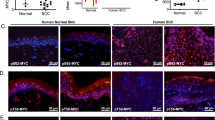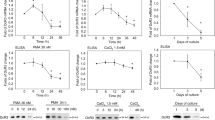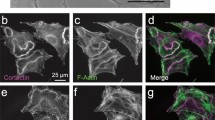Abstract
The human transforming growth factor-alpha (TGF-α) gene is thought to contain five introns and six exons, encoding a transmembrane precursor (proTGF-α) from which the mature polypeptide is released by proteolytic cleavage. We identified a novel 32-nucleotide exon (exon α) within intron 5 and an alternative splice acceptor site in exon 6, splitting exon 6 into two segments: 6A and 6B. Therefore, in addition to wild type (wt) proTGF-α mRNA, which skips exon α, two novel proTGF-α variants are produced: Variant I (VaI), skipping exons α and 6A, and Variant II (VaII) which includes exon α and skips exon 6A. The only significant difference between variant and wt proTGF-α proteins is that the two wt carboxyl-terminal valines are replaced in the variants by five or four other amino acids, respectively. Both variant TGF-α mRNAs were readily detected in human keratinocytes and tumor-derived cell lines. Their protein products were cleaved as efficiently as wt TGF-α in response to the calcium ionophore A23187. However, both variants (but not wt) reduced serum requirements for proliferation in CHO cells. In addition, VaII-expressing CHO cells (not VaI or wt) formed foci in monolayer cultures. These results suggest that variant TGF-α precursors induce autonomous growth.
This is a preview of subscription content, access via your institution
Access options
Subscribe to this journal
Receive 50 print issues and online access
$259.00 per year
only $5.18 per issue
Buy this article
- Purchase on Springer Link
- Instant access to full article PDF
Prices may be subject to local taxes which are calculated during checkout






Similar content being viewed by others
Abbreviations
- TGF-α:
-
transforming growth factor α
- proTGF-α:
-
TGF-α precursor
- VHL:
-
von Hippel-Lindau
- HKc:
-
human keratinocytes
- HPV16:
-
human papillomavirus type 16
- HKc/HPV16:
-
HKc immortalized by HPV16
- HKc/GFI:
-
growth factor-independent HKc/HPV16
- HKc/DR:
-
differentiation resistant HKc/HPV16
- UTR:
-
untranslated region
- CHO:
-
Chinese hamster ovary
- FBS:
-
fetal bovine serum
- RPA:
-
ribonuclease protection assay
- PBS:
-
phosphate-buffered saline
- PMA:
-
phorbol 12-myristate 13-acetate
- DMSO:
-
dimethylsulfoxide
- PKC:
-
protein kinase C
- EGFR:
-
epidermal growth factor receptor
References
Baselga J, Mendelsohn J, Kim YM and Massague J. . 1996 J. Biol. Chem. 271: 3279–3284.
Blasband AJ, Rogers KT, Chen XR, Azizkhan JC and Lee DC. . 1990 Mol. Cell Biol. 10: 2111–2121.
Bosenberg MW, Pandiella A and Massague J. . 1992 Cell 71: 1157–1165.
Brachmann R, Lindquist PB, Nagashima M, Kohr W, Lipari T, Napier M and Derynck R. . 1989 Cell 56: 691–700.
Briley GP, Hissong MA, Chiu ML and Lee DC. . 1997 Mol. Biol. Cell 8: 1619–1631.
Casey PJ and Seabra MC. . 1996 J. Biol. Chem. 271: 5289–5292.
Derynck R, Roberts AB, Eaton DH, Winkler ME and Goeddel DV. . 1985 Cancer Cells 3: 79–86.
Derynck R, Goeddel DV, Ullrich A, Gutterman JU, Williams RD, Bringman TS and Berger WH. . 1987 Cancer Res. 47: 707–712.
DiPaolo JA, Woodworth CD, Popescu NC, Notario V and Doniger J. . 1989 Oncogene 4: 395–399.
DiPaolo JA, Woodworth CD, Popescu NC, Koval DL, Lopez JV and Doniger J. . 1990 Virology 177: 777–779.
Ezzat S, Walpola IA, Ramyar L, Smyth HS and Asa SL. . 1995 J. Clin. Endo. Metab. 80: 534–539.
Holland SJ, Gale NW, Mbamalu G, Yancopoulos GD, Henkemeyer M and Pawson T. . 1996 Nature 383: 722–725.
Jeon S, Allen-Hoffmann BL and Lambert PF. . 1995 J. Virol. 69: 2989–2997.
Knebelmann B, Ananth S, Cohen HT and Sukhatme VP. . 1998 Cancer Res. 58: 226–231.
Kozak M. . 1984 Nucl, Acids Res. 12: 857–872.
Kozak M. . 1997 EMBO J. 16: 2482–2492.
Lee DC, Fenton SE, Berkowitz EA and Hissong MA . 1995 Pharmacol. Rev. 47: 51–85.
Massague J and Pandiella A. . 1993 Annu. Rev. Biochem. 62: 515–541.
Mount SM. . 1982 Nucl. Acids Res. 10: 459–472.
Pfeffer S and Ulrich A. . 1985 Nature 313: 184.
Pirisi L, Yasumoto S, Feller M, Doniger J and DiPaolo JA. . 1987 J. Virol. 61: 1061–1066.
Pirisi L, Creek KE, Doniger J and DiPaolo JA. . 1988 Carcinogenesis 9: (Lond.) 1573–1579.
Qian JF, Feingold J, Stoll C and May E. . 1993 Am. J. Hum. Genet. 53: 168–175.
Seki S, Sakai Y, Kitada T, Kawakita N, Yanai A, Tsutsui H, Sakaguchi H, Kuroki T and Monna T. . 1997 Viechow Arch. 430: 29–35.
Shum L, Reeves SA, Kuo AC, Fromer ES and Derynck R. . 1994 J. Cell Biol. 125: 903–916.
Shum L, Turck CW and Derynck R. . 1996 J. Biol. Chem. 271: 28502–28506.
Wilcox JN and Derynck R. . 1988 Mol. Cell. Biol. 8: 3415–3422.
Zhang FL and Casey PJ. . 1996 Annu. Rev. Biochem. 65: 241–269.
Zyzak LL, MacDonald LM, Batova A, Forand R, Creek KE and Pirisi L. . 1994 Cell Growth Differ. 5: 537–547.
Acknowledgements
W12 clones were a kind gift of Paul Lambert. We thank Craig Woodworth for the human tumor-derived cell lines. We also thank Elena Mourateva for establishing normal HKc cultures, and Darrell Borger and Greg Akerman for critically reading this manuscript. This work was supported by National Institutes of Health Grant CA 62094 (to L Pirisi) and the South Carolina Endowment for Children's Cancer Research (to KE Creek). This work was performed in partial fulfillment of the requirements for the Ph.D degree by X Xu.
Author information
Authors and Affiliations
Rights and permissions
About this article
Cite this article
Xu, X., Liao, J., Creek, K. et al. Human keratinocytes and tumor-derived cell lines express alternatively spliced forms of transforming growth factor-α mRNA, encoding precursors lacking carboxyl-terminal valine residues. Oncogene 18, 5554–5562 (1999). https://doi.org/10.1038/sj.onc.1203091
Received:
Revised:
Accepted:
Published:
Issue Date:
DOI: https://doi.org/10.1038/sj.onc.1203091
Keywords
This article is cited by
-
Human papillomavirus-mediated carcinogenesis and tumor progression
Genome Instability & Disease (2021)
-
Unique carboxyl-terminal sequences of wild type and alternatively spliced variant forms of transforming growth factor-α precursors mediate specific interactions with ErbB4 and ErbB2
Oncogene (2000)



